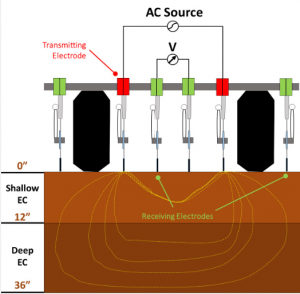What is Electrical Conductivity?

Photo Credit: https://ohioline.osu.edu/factsheet/fabe-565
Soil EC is a measure of the concentration of ions from water-soluble salts in soils, and the test results are indicative of soil salinity. EC is the ability of a material to conduct an electrical current and it commonly is expressed as dS/m or millimhos/centimeter (mmhos/cm). One dS/m = 1 mmhos/cm. Soil EC is inversely proportional to the electrical resistance in soil solution. EC is measured by passing an electrical current through the soil solution. Water-soluble salts in the solution enhance the transfer of electric current (electric conductance).
For classification purposes, a soil is considered as saline if the saturated paste extract electrical conductivity (EC) equals or exceeds 4 deciSiemens per meter (dS/m). However, in terms of crop production, even an EC of less than 4 dS/m can result in considerable yield loss, for example in the case of soybeans. In addition, soil electrical conductivity is an indirect measurement that correlates very well with several soil physical and chemical properties.
Note: An ohm is a unit of resistance and an mho is a unit of conductance. “Siemens” was adopted as a scientific representation of mho in an 1881 conference in England to honor a prominent scientist of the period who studied electrical conductance. Mho usually is used by lay soil scientists today, although dS usually is used in peer-reviewed scientific journals instead of mho.
Do you have an excellent resource that isn’t listed here? Submit it for consideration.
| Title | Source | Resource type and Date | Short Summary / Preview |
|---|---|---|---|
| Soil Quality Indicators: Soil Electrical Conductivity | USDA | NRCS Fact Sheet
Dec 2011 |
Fact Sheet. Soil electrical conductivity (EC) measures the ability of soil water to carry electrical current. Electrical conductivity is an electrolytic process that takes place principally through water-filled pores. Cations (Ca2+, Mg2+, K+, Na+, and NH4+) and anions (SO42-, Cl–, NO3-, and HCO3–) from salts dissolved in soil water carry electrical charges and conduct the electrical current. |
| Soil Electrical Conductivity | USDA | NRCS Fact Sheet
Not Dated |
Soil electrical conductivity (EC) is a measure of the amount of salts in soil (salinity of soil). It is an important indicator of soil health. It affects crop yields, crop suitability, plant nutrient availability, and activity of soil microorganisms which influence key soil processes including the emission of greenhouse gases such as nitrogen oxides, methane, and carbon dioxide. |
| Using Soil Electrical Conductivity (EC) to Delineate Field Variation | Ohio State University | Extension Publication
Jan 2017 |
Guide with information about EC, how to measure, factors influencing EC, and how to generate and interpret an EC map. |
| Pour-through Technique of Measuring Electrical Conductivity of the Substrate | Purdue University | Extension Publication
Mar 2018 |
There are in-house and laboratory-based methods of measuring substrate EC. One popular in-house method is called the pour-through technique. This technique is rapid, inexpensive, and measures EC of solution in the substrate pores (that is, it measures pore-water conductivity). |
| Commercial Greenhouse Production: pH and Electrical Conductivity Measurements in Soilless Substrates | Purdue University | Extension Publication
Jun 2009 |
Monitoring the pH and electrical conductivity (EC) of growing substrates is a way to correct issues before they become problems that damage crops. This publication recommends best practices for establishing a pH and EC testing program in soilless substrates, and outlines the procedures, advantages, and disadvantages of three accepted methods for testing media solutions. |
| Title | Source | Resource type and date | Short Summary |
|---|---|---|---|
| Water and Soil Characterization – pH and Electrical Conductivity | Montana State University | University Webpage
Not Dated |
Electrical conductivity (EC) is a measurement of the dissolved material in an aqueous solution, which relates to the ability of the material to conduct electrical current through it. EC is measured in units called Seimens per unit area (e.g. mS/cm, or miliSeimens per centimeter), and the higher the dissolved material in a water or soil sample, the higher the EC will be in that material. |
| Precision Farming Tools: Soil Electrical Conductivity |
Virginia Tech | Extension Publication
Not Dated |
General guide to EC, instruments that can measure EC, and why it is useful. |
| Soil pH and Electrical Conductivity: A County Extension Soil Laboratory Manual | University of Florida | Extension Publication
Not Dated |
This manual has been designed as a reference source for UF/IFAS Extension office laboratories offering soil pH and/ or electrical conductivity tests to their clients. This manual if followed, will assist county faculty in assuring that these laboratory measurements are done correctly with high quality assurance. |
| What is Soil Electrical Conductivity | Louisiana State University | Extension Publication
Feb 2011 |
This publication defines soil electrical conductivity, how it is measured in the field and its beneficial uses in precision agriculture. |
| Title | Source | Resource type and Date | Short Summary |
|---|---|---|---|
| Field Comparison of Two Soil Electrical Conductivity Measurement Systems |
Proceedings of the Fourth International Conference on Precision Agriculture | Peer-reviewed publication
Jan 1999 |
This publication evaluates two commercially available pieces of equipment, EM-38 and Veris 3100, which measure soil electrical conductivity by using contact and non-contact sensors in the field and how their results correlate with each other and soil water content. |
| Corrective procedures for high and low substrate pH and electrical conductivity | Michigan State University | Extension Webpage
Feb 2018 |
Be prepared this spring with corrective procedures for the battle against high or low substrate pH or electrical conductivity (EC). |
Technical review: March 31, 2020